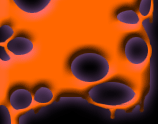|
Method 1 - This is the standard method and most common. We suggest this method for those with smaller tattoos, and those that have had good results with it in the past. Your new tattoo has been bandaged, and it should be removed after atleast four hours. It is very important that your new tattoo be protected from the outside world, as it is a rather large open wound at this time. You should wait to remove the bandage until you can properly clean it with mild soap and warm water. Rinse it well, and pat it dry,allow it to air dry before applying ointment.
You should apply ointment, either A&D, or bacitracin, regularly throughout the day, keeping the tattoo moist, but not smothered. Use just enough ointment to make the tattoo shiny, and blot off any excess. For the fist day or two, your tattoo will require more cleaning, as it will lose fluid at first, this is normal. You want to make sure that moisture doesn't get trapped under the ointment, and that it doesn't stay submerged in water either. We recommend washing your tattoo a couple times throughout the day, using only mild soap, and rinsing and drying well. Frequency of cleaning depends on your lifestyle, use your best judgement, but dont overdue it.
You should only apply ointment for as many days as it takes for your tattoo to peal, this process will take anywhere from three days to week, depending on your system. It will begin to flake like sunburn, just let it happen on its own, and don't pick it. When the entire tattoo has pealed, you need not, and should not, apply any more ointment. If the area is dry and itchy, a good hand lotion should help, this is also normal.
So hears what you should look out for with this method. Should any bubbling of your tattoo occur, you should consider method 2. This bubbling is caused from moisture, such as sweat, getting trapped in your tattoo, and could lead to scabbing. If scabs develop, they can remove the color beneath them. It is very important that they are allowed to dry out completely, and not at any time get water logged. The scab will eventually fall off on its own, and your tattoo should be fine if you keep it dry. Also, some people develop a small allergic reaction to bacitracin, which shows up as a rash around the tattoo, and disappears once the ointment is no longer used. A small percentage of people may develop a more serious reaction, and may require medical attention, so we suggest the use of A&D, unless youve not had problems with bacitracin in the past, be careful.
Method 2 - This is the less conventional method, and tends to work well for larger tattoos, as well as tattoos in areas that will be covered with clothing, as this can cause irritation. If you find that your tattoos have healed poorly in the past, we strongly suggest this method. You should remove your bandage, as in method 1, but you will need no ointment, just plastic wrap. After washing, rinsing, and drying, you will want to completely cover the tattoo in plastic wrap, and use NO ointment.
With this method, you will need to keep the tattoo completely covered with plastic wrap 24 hrs a day, for as long as it takes to peal, similar to method 1. You will want to clean your tattoo 3 to 4 times a day, and change the plastic wrap. We suggest the use of medical tape to hold the plastic wrap in place, as you don't want to over wrap the area, causing you to sweat.
This method, like method 1, has its precautions as well. As before mentioned, moisture can be very detrimental to the healing process, and too much plastic wrap can trap moisture such as sweat. You will also notice that for the first few days your tattoo will lose a bit more fluid than normal, and you may need to change the wrap more regularly. Without the use of a healing agent / antibiotic ointment, youll need to make sure keep the area clean. We do not suggest a combination of these methods. However, everyone heals a bit differently, and youll have to find what works best for you. Dont worry, any tattoo can be touched up, should things go array in healing and you lose some color.
We wish to strongly reiterate that your new tattoo is an open wound, and needs to be treated as one. Engaging in actions such as swimming, tanning, removing the bandage early, and just disregard for it, is just asking for trouble. You will be surprised just how easily it can get infected or scab up and lose color. Give your tattoo the time it needs to properly heal, its going to be on you for the rest of your life, and it only takes a week or two of your attention to ensure it looks good forever.
|

